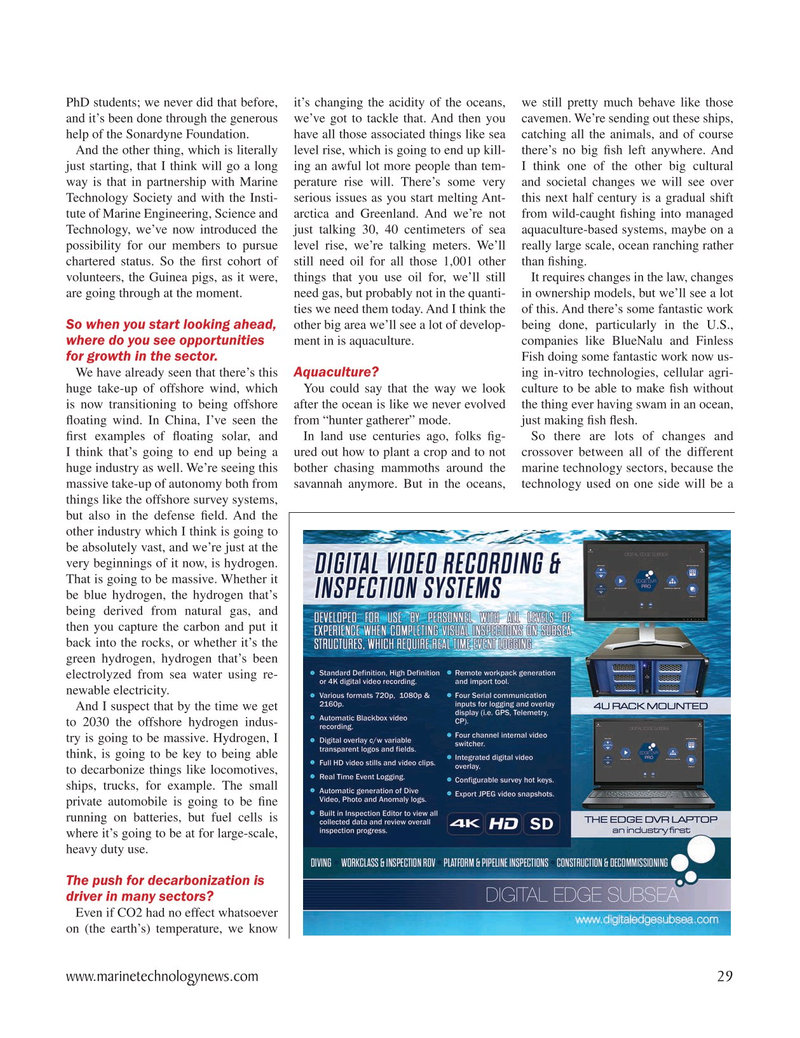
Page 29: of Marine Technology Magazine (November 2020)
Read this page in Pdf, Flash or Html5 edition of November 2020 Marine Technology Magazine
PhD students; we never did that before, it’s changing the acidity of the oceans, we still pretty much behave like those and it’s been done through the generous we’ve got to tackle that. And then you cavemen. We’re sending out these ships, help of the Sonardyne Foundation. have all those associated things like sea catching all the animals, and of course
And the other thing, which is literally level rise, which is going to end up kill- there’s no big ? sh left anywhere. And just starting, that I think will go a long ing an awful lot more people than tem- I think one of the other big cultural way is that in partnership with Marine perature rise will. There’s some very and societal changes we will see over
Technology Society and with the Insti- serious issues as you start melting Ant- this next half century is a gradual shift tute of Marine Engineering, Science and arctica and Greenland. And we’re not from wild-caught ? shing into managed
Technology, we’ve now introduced the just talking 30, 40 centimeters of sea aquaculture-based systems, maybe on a possibility for our members to pursue level rise, we’re talking meters. We’ll really large scale, ocean ranching rather chartered status. So the ? rst cohort of still need oil for all those 1,001 other than ? shing. volunteers, the Guinea pigs, as it were, things that you use oil for, we’ll still It requires changes in the law, changes are going through at the moment. need gas, but probably not in the quanti- in ownership models, but we’ll see a lot ties we need them today. And I think the of this. And there’s some fantastic work
So when you start looking ahead, other big area we’ll see a lot of develop- being done, particularly in the U.S., ment in is aquaculture. companies like BlueNalu and Finless where do you see opportunities
Fish doing some fantastic work now us- for growth in the sector.
We have already seen that there’s this ing in-vitro technologies, cellular agri-Aquaculture?
huge take-up of offshore wind, which You could say that the way we look culture to be able to make ? sh without is now transitioning to being offshore after the ocean is like we never evolved the thing ever having swam in an ocean, ? oating wind. In China, I’ve seen the from “hunter gatherer” mode. just making ? sh ? esh.
? rst examples of ? oating solar, and In land use centuries ago, folks ? g- So there are lots of changes and
I think that’s going to end up being a ured out how to plant a crop and to not crossover between all of the different huge industry as well. We’re seeing this bother chasing mammoths around the marine technology sectors, because the massive take-up of autonomy both from savannah anymore. But in the oceans, technology used on one side will be a things like the offshore survey systems, but also in the defense ? eld. And the other industry which I think is going to be absolutely vast, and we’re just at the very beginnings of it now, is hydrogen.
That is going to be massive. Whether it be blue hydrogen, the hydrogen that’s being derived from natural gas, and then you capture the carbon and put it back into the rocks, or whether it’s the green hydrogen, hydrogen that’s been electrolyzed from sea water using re- newable electricity.
And I suspect that by the time we get to 2030 the offshore hydrogen indus- try is going to be massive. Hydrogen, I think, is going to be key to being able to decarbonize things like locomotives, ships, trucks, for example. The small private automobile is going to be ? ne running on batteries, but fuel cells is where it’s going to be at for large-scale, heavy duty use.
The push for decarbonization is driver in many sectors?
Even if CO2 had no effect whatsoever on (the earth’s) temperature, we know www.marinetechnologynews.com 29
MTR #9 (18-33).indd 29 11/3/2020 6:15:05 PM

 28
28

 30
30
